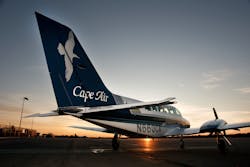Cape Air Sustains Cessna 402 Fleet While Searching for Replacement
Here’s the essence of it: Cape Air/Nantucket Airlines is pulling all the stops to sustain its backbone Cessna 402C fleet, while scouring the planet for its as-yet-unbuilt replacement aircraft. It’s a real balancing act, one at which the Part 135 carrier has honed to an art form.
The venerable piston-engined 402C first rolled off of Cessna’s assembly line back in 1979. In the blink of an aeronautical eye its six-year production run was over, the last of the sleek twins closing down the 402 line in 1985. For those of you keeping count that was 30 years ago.
Cape Air’s far-flung operational footprint – with flying emanating from Hyannis, MA; San Juan, Puerto Rico; Albany, NY; St. Louis, MO; Billings, MT; and Micronesia – couples with high-cycle operations and high-hour airframes to challenge the best of aircraft maintainers and fleet planners. In all, it serves 44 destinations.
To say that Cape Air’s operations rest on the back of the 402 understates the point. Cape Air/Nantucket Airlines sports a fleet of 90 aircraft. 82 of them are 402s. By the numbers, here’s the profile: “Our average utilization, per airplane on a yearly basis, is about 3.7 hours per day across the fleet,” says Jim Goddard, Cape Air’s senior vice president of fleet planning, acquisitions and technical operations. “Our average airplane does six cycles per day.” All of that puts pressure on maintenance spend per flight hour, a figure Goddard declines to disclose for competitive reasons.
What he and Jeffrey M. Schafer, director of MRO and fleet programs, are happy to discuss are the innovative ways the carrier maintains 402 airframes and powerplants to safely wring the most of what the aging Cessnas have to offer. What MRO chief Schafer manages is at the epicenter of the carrier’s efforts. It’s “dedicated strictly [to fleet] sustainability,” says Goddard. No third-party work.
Twenty-three of Cape Air’s 100 or so A&P technicians work at the airline’s Hyannis MRO maintaining and overhauling airframes.
That overhaul work is extensive. “You’d be amazed what we do with the structural replacement process that we have,” says Goddard. Case-in-point is the 402’s forward wing spar. The specific issue was the spar’s inspection process. As the aircraft aged, “we weren’t necessarily comfortable [with that process],” he says.
That, in part, prompted the airline to purchase an Australian-operated aircraft which had been fitted with a spar strap, “an external doubler,” says Jeff Schafer, “that’s affixed to the lower spar area of the wing structure [which] adds an extra level of safety to the [wing].”
The purchase led to a conference with Cessna engineers in 1999 in which Goddard told the airframer he wanted to incorporate the fix on its then 50-strong 402 fleet. Goddard says Cessna told Cape Air, “’If you commit to [partner] on all 50, we’ll do a Service Bulletin for it.” Thus was born a kit, one that became available in 2001.
Test-bed template
A separate 402C was the perfect candidate for a tear-down analysis, flying as it had for some seven to eight different airlines before ending up with Cape Air. Among its operators were Grand Canyon Airlines and Provincetown-Boston Airlines. The former was noted for the turbulence its aircraft handled; the latter, which did a lot of Florida flying, dealt with salt-laden corrosive conditions. “So," says Goddard, it had “a history of all these different types of operational profiles – on one airplane.”
Its final flight was, ironically enough, to Wichita, home of the National Institute for Aviation Research. NIAR spent two years subjecting the aircraft to both destructive and nondestructive testing. All the while, Cape Air monitored the effort. In the end, it used what was learned as a maintenance/sustainment template for its backbone fleet of 402s. The idea was to develop better ways of proactively maintaining the airplanes.
In addition the spar-strap lesson [learned prior to NIAR], de-bonding and corrosion inspections were focused on. “What’s important to take away from this,” says Goddard, “is [that] instituting the inspection processes we did during that timeframe allowed us the visibility in the areas that we needed to concentrate on.”
Safety comes first, but, concedes Goddard, while you operate a safe carrier you can also “have a very unreliable and unpredictable airline. Because airplanes can come into the hangar … then you’re AOG … for 500 to 600 man-hours.”
That led to Cape Air’s strategic initiative to proactively replace main structural elements on the 402 fleet. The immediate result was an in-house MRO, Cape Air’s own FAA repair station. NIAR nailed down specifically what Schafer and his crew should look out for. Corrosion was culpable for its share of the problems. He says aircraft purchased by Cape Air (which had flown the Caribbean and Florida in particular) comprised the first round of candidates for the company’s strategic structural replacement efforts.
Now that fleet sustainment is on solid ground, just how much longer does Cape Air expect to fly its venerable 402’s? The aircraft are well into their 30s, and ‘this is the first time [they’ve] undergone this [structural replacement],” says Goddard. In-house MRO technicians fashioned 90 percent rebuilt wings, fitting them with new bonded structure – wing skins, engine beams, wing attach fittings, spar straps. “So,” he says, “theoretically another 15 or 20 years [service] would be a no-brainier. The problem is the cost to do that.”
One, two punch: fleet sustainment and fleet replacement
As Schafer and his crew work the airplanes up in Hyannis, Goddard spends a fair bit of time on the road drumming up interest in a 402 replacement, as well as concomitant powerplants capable of being multi-fuel follow-ons to the Continental Motors TSIO-520-VB.
Cape Air has no interest in nine-passenger single-engine aircraft, nor the propjet that may power them. None. “We’re over water,” says Goddard. “We’re over mountainous terrain. We do about 150,000 – 160,000 flight operations a year. And with human error, with mechanical failure, there are cases in which we have engine failures.” Given this operational profile, single engines are out. Given the comparative maintenance costs between reciprocating engines and propjets, the latter are out, adds Schafer.
In its bid to bridge the gap between fleet sustainment and fleet replacement Cape Air hopes there’s strength in numbers. That’s why Goddard is busy trying to enlist help from other operators to support the development of alternative airframes. “What you want is an airframe that has the ability to adapt to different types of powerplants, depending on the region of the world in which the airplane is operating.” For example, avgas is scarce in Africa. That means an airplane capable of using a yet-to-be-developed Jet A piston fuel or a turbine.
“[We’re] really looking to bring those airframe and engine manufacturers together and discuss opportunities,” echos Cape Air MRO chief Jeff Schafer. Discuss them not just with Cape Air, “but with the industry as a whole. We’re simply looking for the aircraft that makes sense for us – and we’re hoping to make others understand that what works for us may fit their model as well.”
In the meantime, the work on sustaining the elegant, but aging, Cessna 402 continues unabated up on Cape Cod.




